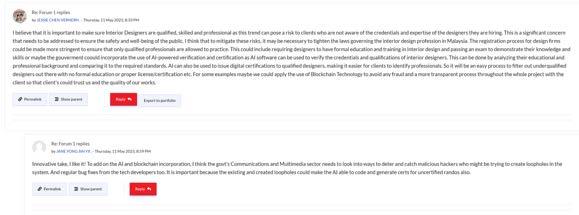
2 minute read
Architects Act: Tighten The Law In Registration
Abstract: Interior designer is a profession that held a lot of responsibility in a construction process. As an interior designer, one must possess the necessary knowledge and skills to create functional and aesthetically pleasing spaces that meet the needs of their clients. This involves understanding architectural principles, building codes, and safety regulations. Without proper education and training, a person may not have the necessary expertise to take on such a responsibility, and this can lead to serious consequences. In recent years, there have been a lot of interior design firms being set up by people who haven't gone through proper educationinregardstothisprofession.Thistrendcanbeattributedtothe rise of the gig economy, which allows people to work as freelancers or start their own businesses without the need for formal qualifications. However, this can pose a risk to clients who may not be aware of the qualifications and experience of the designer they are hiring. Should we further tighten the laws and make the registration of a design firm more stringent?Discuss
As an interior architecture student, I firmly believe that the role of an interior designer or architect in the construction process comes with significant responsibilities. It necessitates a thorough grasp of architectural principles, building codes, and safety regulations to create functionalandvisuallyappealingspacesthatcatertoclients'specificrequirements.
Advertisement
In recent times, there has been a noticeable surge in the number of individuals establishing interior design firms without the necessary education and training. This phenomenon can be attributed to the growing popularity of the gig economy, which allows people to work independently or start businesses without formal qualifications. However, this poses risks to clientswhomaybeunawareofthequalificationsandexpertiseofthedesignerstheyhire.
To address this concern, it is crucial to implement more stringent laws and regulations governing the registration of design firms. By doing so, we can ensure that interior designers have undergone proper education and training, safeguarding the interests of clients. This would not only elevate the overall professionalism within the industry but also instill confidence in clients, assuring them that they are hiring qualified professionals with the necessaryskillsandknowledge.
Possible measures to strengthen regulations could include setting specific criteria for registration, such as a minimum level of formal education in interior design, a prescribed duration of practical experience, or the completion of recognized certification programs. By enforcing such requirements, clients can have greater assurance that the interior designers theychoosehavemetestablishedstandardsofcompetenceandprofessionalism.
It is important, however, to strike a balance between regulation and encouraging innovation within the industry. Recognizing alternative pathways for talented individuals without formal education, such as through portfolio assessments or mentorship programs, would ensure that creativityanddiverseperspectivesarevaluedandincorporated.
Furthermore, educating clients about the significance of hiring qualified interior designers and the potential risks associated with unqualified practitioners is crucial. By promoting awareness and understanding among clients, they can make informed decisions when selecting a design firm, contributingtoamorereputableandthrivingindustry.
In conclusion, reinforcing laws and regulations and making the registration of design firms more rigorous would serve to protect clients and raise the standards of the interior design profession. Striking a balance between regulation and innovation, as well as enhancing client education,willcontributetoahealthierandmorerespectedindustry.
Below attached some images of the forum discussion and my opinion on the topic alongside somerepliesordebateswithmycoursemates:






